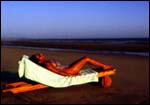


|
|
 |
| HOME | TRAVEL | TRAVELOG | ||

Dazzling Diu ... an undiscovered beach getaway Text and photographs: Sanjay Singh Badnor There's a tiny island in the sun, a mere 13 kilometres long and a slender three kilometres wide, located off the coast of southern Gujarat, out in the Gulf of Khambhat. Name of Diu, it is fringed with palms and dotted with ruins dating back to the days of Portuguese rule.
But after exploring this town's maze of narrow, winding streets and plazas and beautifully designed buildings, things get clearer, history adding to the tremendous charm of Diu and setting it apart in every possible way from the nearby Gujarati towns of Kodinar and Una. Diu was a key trading centre from the 1300s to the 1500s for the Ottoman Turks, who controlled the Arabian Sea routes. Diu was a port of choice for opium exporters of Malwa, Madhya Pradesh. Realising its strategic importance, the Portuguese decided to capture this enclave. Their first attempt in 1531 was unsuccessful. The reigning Sultan of Gujarat at the time, Bahadur Shah, quashed the invasion with the help of the Turkish navy. However the Mughal emperor of India, Humayun had a long-standing quarrel with Bahadur Shah and came down to settle it. Bahadur Shah was beaten and exiled to Malwa but returned home while Humayun was otherwise engaged. But weaker now, he succumbed to pressure from both the Portuguese and the Mughals and, in 1539, ceded control of Diu and the mainland town of Ghoghla to the Portuguese, who proceeded to build a fort on the island. Diu struck me as a very much like a Mediterranean town, carefree in spirit. Of late Diu has become a popular tourist destination, with both foreign as well as domestic tourists. All drawn by Diu's miles of empty surf, sea and sand. And after having one's fill of these, there are the Portuguese ruins, with their strange colonial air, to explore. Also, Diu is a free port where liquor is freely available without restrictions unlike its neighbouring state, Gujarat. Numerous hotels facing the sea, lively rooftop bars, multicuisine restaurants and beach resorts have sprung up in this little town. And during the season, from October to March, Diu teems with tourists. It has also been included on the itinerary of the Royal Orient Express, a luxury train that takes tourists across Gujarat in five-star comfort. The island is separated from the mainland by a narrow channel of water. However both ends of isle are connected to the mainland by bridges. It is therefore possible to enter Diu either through the Portuguese village of Ghoghla in the east or from Veraval or Somnath in the west. The Fort de Mar, built by the Portuguese in 1541, is dilapidated and decaying slowly. But it is still the island's major tourist attraction, also doubling up as the jail. Naturally, for the mammoth edifice, with its double moat, seems fairly impregnable. It is claimed that the historic fort was constructed by Vasco da Gama. However amongst the numerous cannons which can be seen lined up on the fort ramparts, one bears a legible script claiming it was built in 1624 by Don Diego de Silva Conde of Porta Legre during the reign of King Don Philippe of Spain. Diu's main industry is fishing, followed by distilleries, tourism and salt-making. The Diu harbour, where fishing trawlers are moored, has a delectable atmosphere and is hub of all activity. One can spend a happy few hours at day break, just watching the daily morning rituals of the fishermen congregated on the docks sipping cups of tea, the side-slipping trawlers claw their way to sea, the giant blocks of ice being unloaded... The Portuguese-style town square houses an interesting vegetable market. Nearby is a fish market where the early morning catch goes on sale, business peaking around 10 am. The labyrinth of shady streets that lead off from the main square are lined with houses, painted in bright colours. Not too far away are Diu's three grand churches. The majestic looking St Paul's Church is actually Diu's only functional church, the others having been adapted for other functions. That's just as well because only a few Christian families are left now in Diu. The church itself boasts of beautiful wooden carvings and old paintings. And the views from its terrace of the waterfront, the beaches and the deep blue sea is simply awesome. The Church of St Thomas now houses the Diu museum and an impressive collection of statues of Catholic origin. St Francis of Assisi, the third church, has become a hospital. But Diu is famous for its beaches and so I headed over to the south face of the island to check them out. Nagoa beach, Jallandhar beach, Chakratirth beach and Sunset Point, I discovered, were not your conventional palm-fringed swathes of sand. They were incredibly picturesque, fairly unspoilt and absolutely safe for swimming. The sea along the Gulf of Cambay is a vivid blue and foaming with surf. Plenty of tourist were out on the sand, tanning themselves gold.
Fast Facts
How to get there
Where to stay
|
|
|
|
|
|
|
|
|
HOME |
NEWS |
BUSINESS |
CRICKET |
MOVIES |
CHAT
INFOTECH | TRAVEL | LIFE/STYLE | FREEDOM | FEEDBACK |
|